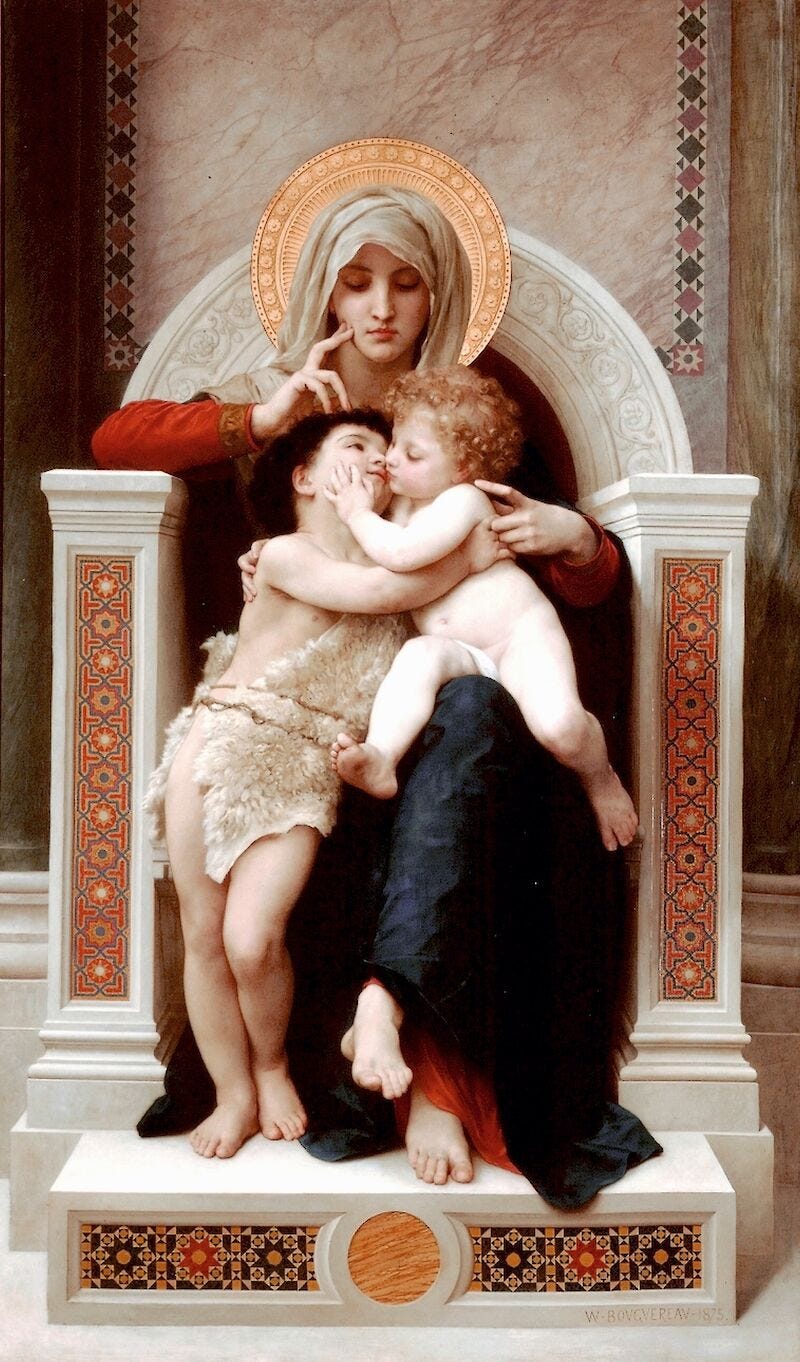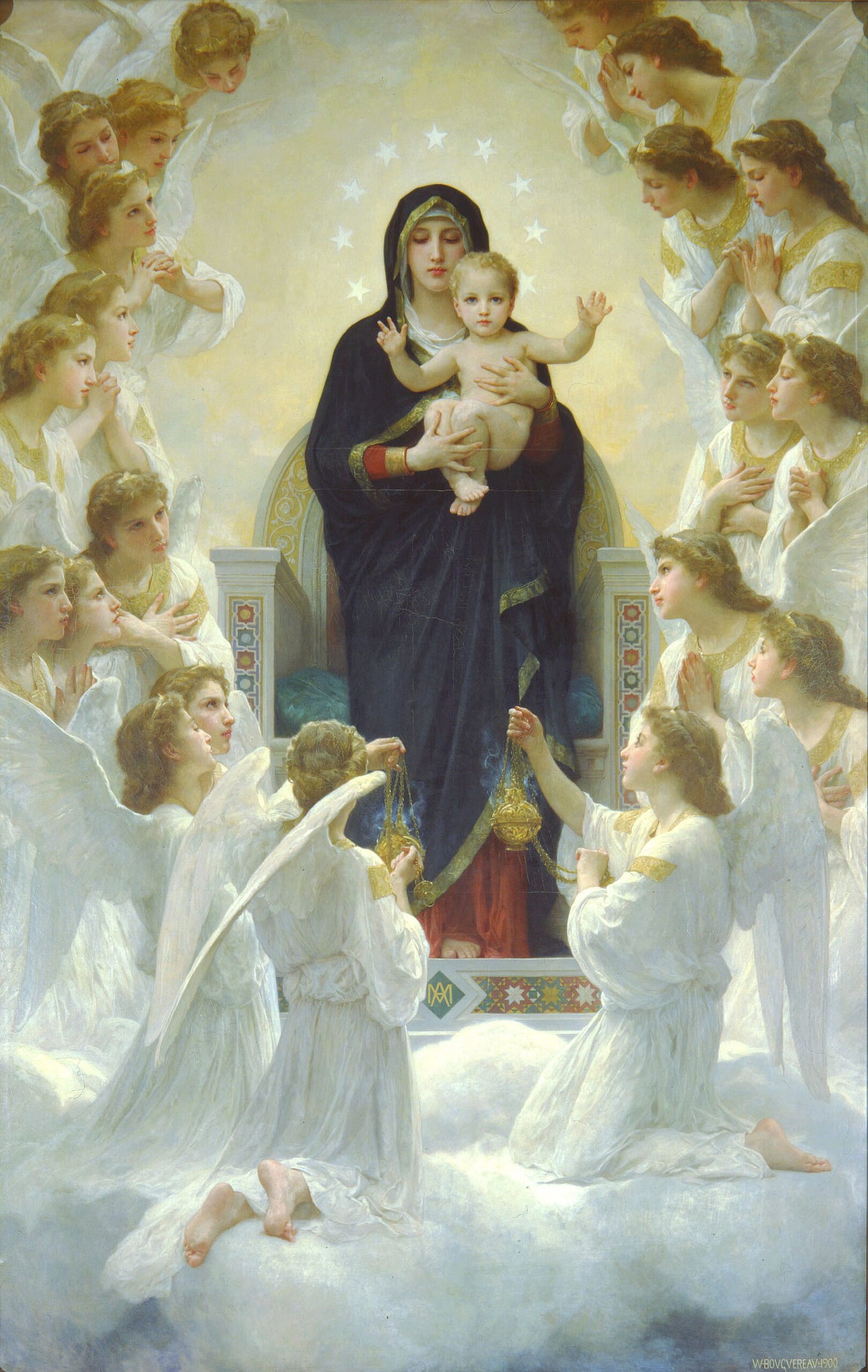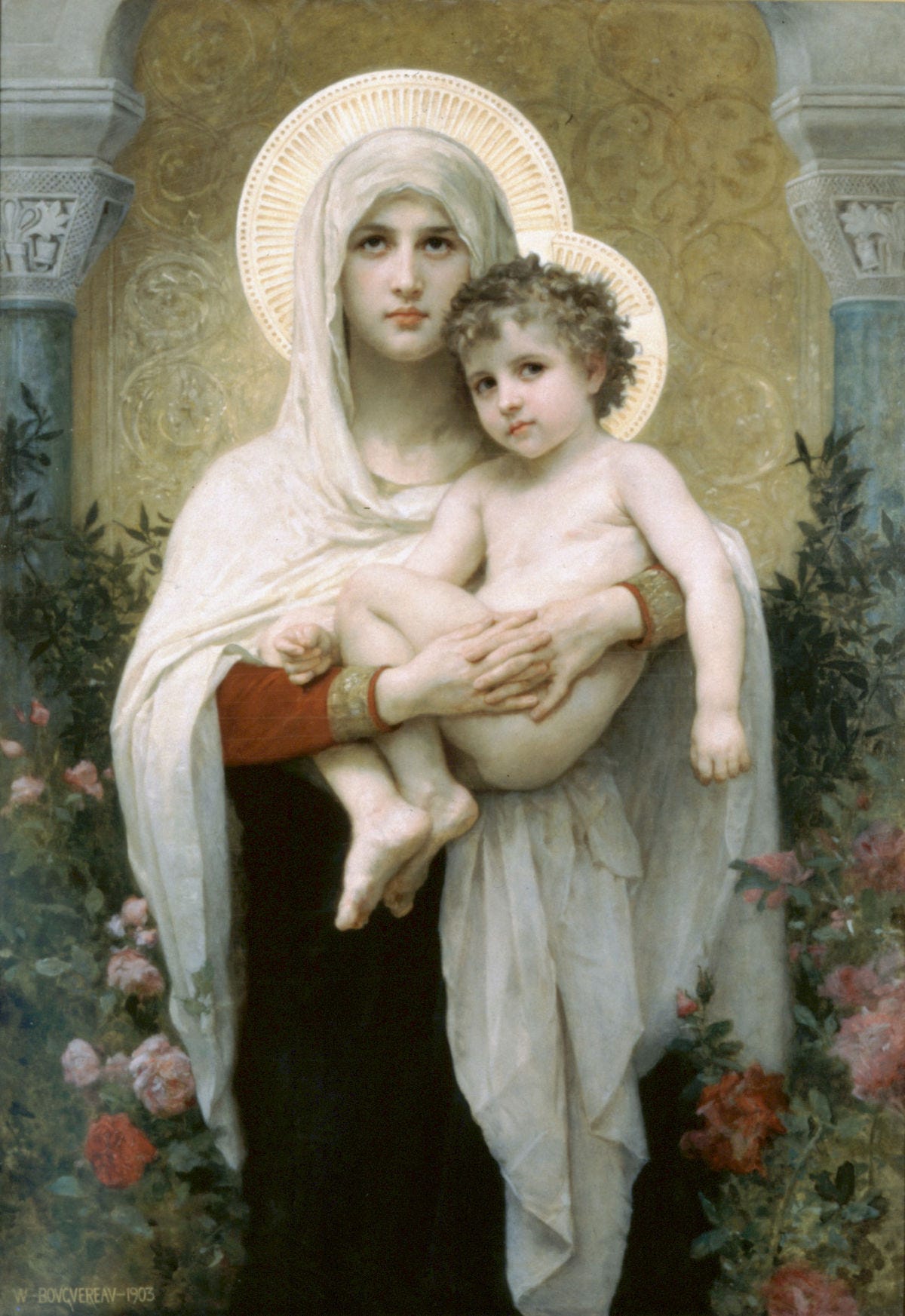How I Fell in Love With the Blessed Virgin Mary as a Catholic Convert
The depth and beauty of Marian devotion
In this essay, I want to share something really close to my heart: why, as a new Catholic convert, I’m falling madly in love with Marian devotion. The Rosary has changed my life. It has conquered all vice and addiction in my life that had kept me enslaved for decades. It has kept me entirely out of mortal sin since I started praying all 20 Mysteries every single day. I am a new man, forged in the fires of Marian devotion.
My Southern Baptist Background
I grew up Southern Baptist, and we didn’t talk about Mary that often. It was always Jesus as the central figure of salvation. And for Catholics, that’s still true. Jesus is still the Redeemer, the Savior, the one through whom salvation comes.
But Catholics have a deeper appreciation for the role that the Blessed Virgin Mary played in salvation history.
For Evangelicals and Protestants, Mary’s role is often downplayed. She’s almost incidental to the story, rather than a central figure. While Catholics don’t think she is the central figure (that’s Jesus, obviously), the Virgin Mary is understood as a central figure.
Protestants and Evangelicals will often ask: Where is all this found in the Bible? Where is this veneration of Mary in Scripture? One of the oldest devotional prayers in Christian history is addressed to Mary as our protectress. It goes:
"We fly to your patronage, O Holy Mother of God. Despise not our petitions in our necessities, but deliver us always from all dangers, O glorious and Blessed Virgin."
This is one of the earliest recorded prayers in Christian tradition. From the very first centuries, Christians held Mary in the highest regard in both the East and West. Why is that?
The Immaculate Conception and the New Eve
In my opinion, the key doctrine is the Immaculate Conception and Mary’s role as the New Eve and the New Ark of the Covenant. If Christ is the New Adam, it’s only logical to ask: Who is the New Eve?
Genesis is not a story just about Adam alone. It is not a story about a man acting alone. It’s fundamentally a story about a man and a woman. When Adam and Eve sinned, humanity fell. But God makes a prophecy, a prediction about salvation history. This is known as the Protoevangelium, the first gospel.
In Genesis 3:15, God says to the serpent:
"Because you have done this, you are cursed more than all animals, domestic and wild. You will crawl on your belly, groveling in the dust as long as you live. And I will cause hostility between you and the woman, and between your offspring and her offspring. She will strike your head, and you will strike his heel."
There’s some dispute about the translation of “she will strike your head,” but the Latin Vulgate uses "ipsa"—"she." There are solid exegetical reasons to support this. Nonetheless, the key point is that the hostility here is not between the serpent and the man, but between the serpent and the woman.
As St. Maximillian Kolbe says, “The conflict with Hell cannot be maintained by men, even the most clever. The Immaculata alone has from God the promise of victory over Satan. She seeks souls that will consecrate themselves entirely to her, that will become in her hands forceful instruments for the defeat of Satan and the spread of God’s kingdom.”
Mary as the New Eve
This universal "woman" represents the New Eve. If Christ is the New Adam, Mary is the New Eve. This is a fundamental typological theme that runs throughout the whole Bible. The Virgin Mary plays a critical role in salvation history by being the vessel through which the Incarnation happens.
The Holy Spirit comes down into the world through her, enacting the will of God. Jesus is the only person in history who ever created His own mother. The Nicene Creed affirms that through Him all things were made, which also includes Mary. And it does not just make intuitive sense that He would create a perfect vessel for Himself?
Would He choose to create a flawed, sinful woman to be His mother? If Adam and Eve brought sin and death into the world, and Satan gained authority over humanity through death, then it makes sense that Jesus would conquer death through a vessel not controlled by sin. The Catholic Catechism makes this point in citing St. Irenaus:
As St. Irenaeus says, "Being obedient she became the cause of salvation for herself and for the whole human race." Hence not a few of the early Fathers gladly assert...: "The knot of Eve's disobedience was untied by Mary's obedience: what the virgin Eve bound through her disbelief, Mary loosened by her faith."Comparing her with Eve, they call Mary "the Mother of the living" and frequently claim: "Death through Eve, life through Mary." (CCC 494)
The Immaculate Vessel
To be under the influence of original sin is to be under the influence of death, and by extension, Satan. So, Jesus grants Mary a special grace from the first moment of her conception, preserving her from original sin. He makes her a sacred, worthy vessel.
This is why the Litany of Loreto calls her, “Spiritual vessel,” “Vessel of honour,” “Singular vessel of devotion,” “House of gold,” “Ark of the covenant,” and “Gate of heaven.”
This concept is also prefigured in the Old Testament by the Ark of the Covenant, the holy vessel where God’s presence dwelt. In Exodus, God gives precise instructions for building the Ark. It had to be made of incorruptible wood and lined with pure gold. In this context, “pure gold” means that it’s been purified in the fire of all impurities.
Mary as the New Ark of the Covenant
“Mary is that happy ark, in which those who take refuge will never suffer the shipwreck of eternal perdition” ~ St. Bernard of Clairveaux
The Ark was the place where the glory cloud, the presence of God, would overshadow it. In the Annunciation, when the Holy Spirit comes upon Mary, the same word is used: "overshadow." This is not accidental.
Even Protestant scholars recognize the parallel. The language of "overshadowing" clearly connects the Annunciation of Mary to the Ark of the Covenant.
And the Ark? It was lost in the Old Testament. But where does it show up again in salvation history? In the Book of Revelation, at the end of history.
In Revelation 11, it says:
“Then God’s temple in heaven was opened, and the Ark of His Covenant was seen within His temple.”
And immediately after at the beginning of Chapter 12:
“And a great sign appeared in heaven: a woman clothed with the sun, with the moon under her feet, and a crown of twelve stars on her head. She was pregnant and cried out in labor pains.”
Who is this woman? She gives birth to the one who will rule the nations with an iron rod: Jesus Christ. And who is His mother? The Blessed Virgin Mary. Protestants like to claim this “woman clothed with the sun” is merely a metaphor for Israel, but the linguistic evidence doesn’t support that interpretation.
The Greek consistently uses feminine singular pronouns and participles (e.g., ἐτεκεν – “she gave birth” in v.5) to describe a specific individual woman, not a collective entity like a nation. Israel, when spoken of corporately in the Old Testament, is often personified, but the strong emphasis on her personal actions (conceiving, crying out in birth pangs, fleeing, being nourished, etc.), reads more naturally as a real woman.
The Queen Mother of the Davidic Kingdom
“Mary means Star of the sea, for as mariners are guided to port by the ocean star, so Christians attain to glory through Mary’s maternal intercession.” ~ St. Thomas Aquinas
In the Davidic kingdom, the queen was not the wife of the king, but his mother. So Mary is not just any woman; she is the Queen Mother of the King of Kings.
She has the moon under her feet because she reflects the light of the Son. As St. Thomas says, “As the moon receives its light from the sun and pours it upon us, so does the Blessed Virgin receive the light of God and pour it upon us.”
She is the spotless mirror, the perfect handmaiden of God who said yes to His will. As the Gate of Heaven, her function is acting as the mediator or “go-between” between the Blessed Trinity and the Incarnation, the fundamental event that kicks off man’s salvation from death and sin.
When the Holy Spirit came down upon her, He did not force Himself on her. He asked for her consent. Like in a sacramental marriage, consent is key. Her yes, her fiat, “let it be done to me,” was critical.
God didn’t have to do it this way. He could have incarnated as a fully formed 33-year-old God-man coming down from Heaven in thunderous glory. But He chose to become flesh through the mediation of Mary, to come down from Heaven as a humble human embryo and allow Himself to be nourished and fed by a fully human Mother. As St. Augustine says, “Him whom the heavens cannot contain, the womb of one woman bore. She ruled our Ruler; she carried Him in whom we are; she gave milk to our Bread.”
And since Jesus is the source of all grace, and Mary is the one through whom He came, it logically follows that Mary is the mediatrix of grace because, historically speaking, her fiat is the key causal linkage kicking off the historical process that culminated in the Infinite Fount of Mercy and Grace to flow from the Cross.
Again, St. Augustine says, “Mary, having merited to give flesh to the divine Word, and thus supply the price of our redemption, that we might be delivered from eternal death; therefore she is more powerful than all others to help us to gain eternal life”
The Theology of the Trinity and Creation
Let’s go back to Genesis again: "The Spirit of God was hovering over the waters. And God said, 'Let there be light.'"
This is Trinitarian. God the Father is the Lover. The Son is the Beloved. The love between them is the Holy Spirit, the breath of life.
God speaks the Word, Jesus, and the Spirit makes it efficacious. The Holy Spirit is the means through which the Word acts in the world.
When God created Adam, He breathed the breath of life into him. The Holy Spirit gives life. Jesus is the life, but the Spirit is how that life comes into you.
“May the Most Holy Virgin, who was the first to practice the gospel perfectly and in all its severity, even before it was proclaimed, spur us on to follow closely in her footsteps.” ~ St. Padre Pio
Jesus said, “If you love me, keep my commandments. And I will send the Advocate—the Spirit of Truth.”
Well, who most perfectly kept God’s commandments? Mary. She was perfectly obedient to God’s Will her entire life. She is the perfect disciple. Never once did she act contrary to God’s Will. Because of this, does it not make sense that it’d be appropriate for the Holy Spirit to be her Spouse?
She said yes, even knowing it would bring suffering to her beloved son, and sorrows to herself as a loving Mother. And because of that “yes”, the Spirit overshadowed her. The Incarnation happened. The Word became flesh.
The Nicene Creed affirms the Holy Spirit is “the Lord, the giver of Life.”
In Isaiah 11:1, we see a prophecy about this:
Out of the stump of David’s family will grow a shoot—
yes, a new Branch bearing fruit from the old root.
Jesus is the “fruit.” The mediating “branch” between the stump and the fruit that carries the fruit is Mary, the Mediatrix, the Vessel.
In Genesis, Eve sinned by eating the forbidden fruit from a Tree and brought death into the world. On Calvary, the fruit was placed back onto a Tree to be sacrificed, so that we may eat it in the Eucharist and thereby gain back our Eternal Life, through Christ.
One of the items in the Ark of the Covenant was Aaron’s priestly rod. In Numbers, Aaron’s priestly rod miraculously budded with flowers, signifying God’s divine choice of Aaron and his lineage for the priesthood, confirming their authority and ending disputes among the tribes.
Similarly, Jesus is the new Eternal High Priest in the line of Melchizedek, both King and Priest. From the dead tree of the Cross blossoms new Life, the “Rivers of living water will flow from his heart” when it is pierced. These “living waters” of Blood and Water, which flowed from His heart, are the Spirit, which sanctifies us and thereby makes us worthy to come into the presence of God. As Hebrews says,
“Let us go right into the presence of God with sincere hearts fully trusting him. For our guilty consciences have been sprinkled with Christ’s blood to make us clean, and our bodies have been washed with pure water.”
So it is through the Mediation of Mary in the Incarnation which brought forth the “blessed fruit of her womb” which was sacrificed on the tree, and which we consume in the Eucharist as the “source and summit” of the Christian life, sanctifying us by the power of the Spirit so that we may participate in Christ’s Divinity and have Everlasting Life.
A Deeper Understanding of the Rosary
This is why the Hail Mary is so powerful. It's the angelic salutation. “Hail Mary, full of grace, the Lord is with thee.” It marks the moment the Incarnation was announced.
The Rosary is a meditation on the Incarnation and the mysteries of salvation. When we say it, we’re not taking anything away from Jesus; we’re appreciating the very way He chose to come into the world.
“With the Rosary, the Christian people sits at the school of Mary and is led to contemplate the beauty on the face of Christ and to experience the depths of his love.” ~ Pope St John Paul II
Mary Is Not God—but She Is the Greatest Creature
Catholics don’t sacrifice to Mary. The Mass, the Eucharistic sacrifice, is offered to God alone. That’s how we know Mary is not God.
But Mary is the most perfect, magnificent, beautiful creature God ever created. St. Louis de Montfort said that compared to God, Mary is nothing, a speck of dust, but compared to everything else, she is the highest created creature ever made by the Father.
God didn’t need her. He chose her. And that choice is part of His eternal will.
Don’t Be Afraid to Love Mary
“Never be afraid of loving the Blessed Virgin too much. You can never love her more than Jesus did.” ~ St. Maximillian Kolbe
So don’t be afraid of loving Mary. Jesus loved His mother. You can’t love her more than He did.
Once you understand Mary, you understand Jesus more deeply. You see the wisdom of the Church in lifting her up.
Mary humbles herself so that God may be exalted. She always points to Him. And in doing so, she brings us to Him.
“A son of the Immaculate Heart of Mary…is a man who unceasingly expends himself to light the fire of divine love in the world. Nothing stops him.” ~ St. Anthony Mary Claret








That was superb! Would you mind if I posted it in my Facebook page? (Trad Catholic page).
That's great! What a good and concise explanation. Well done. I may share it with my RCIA class next year. A suggested follow up: the Assumption and perpetual virginity :)